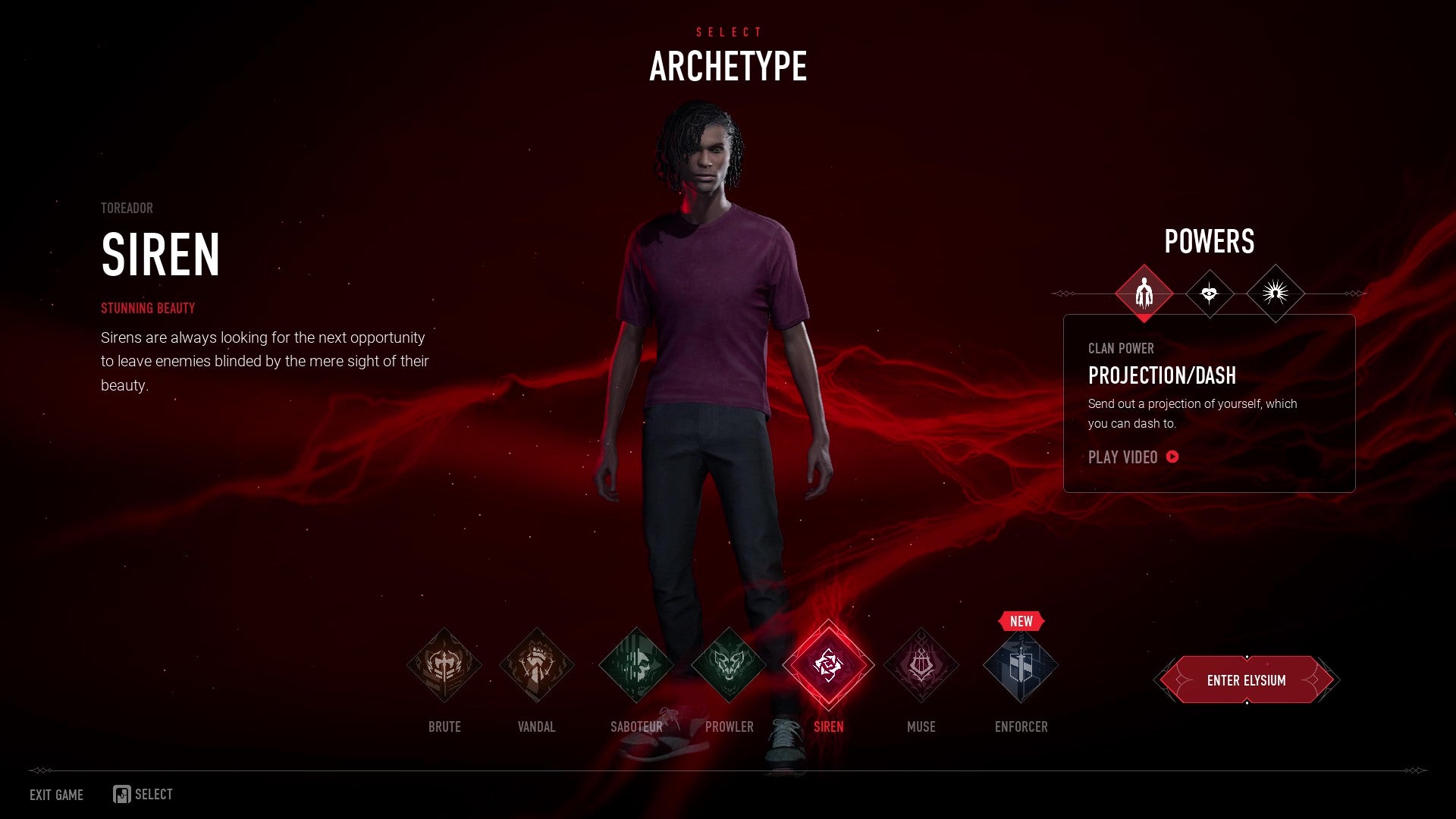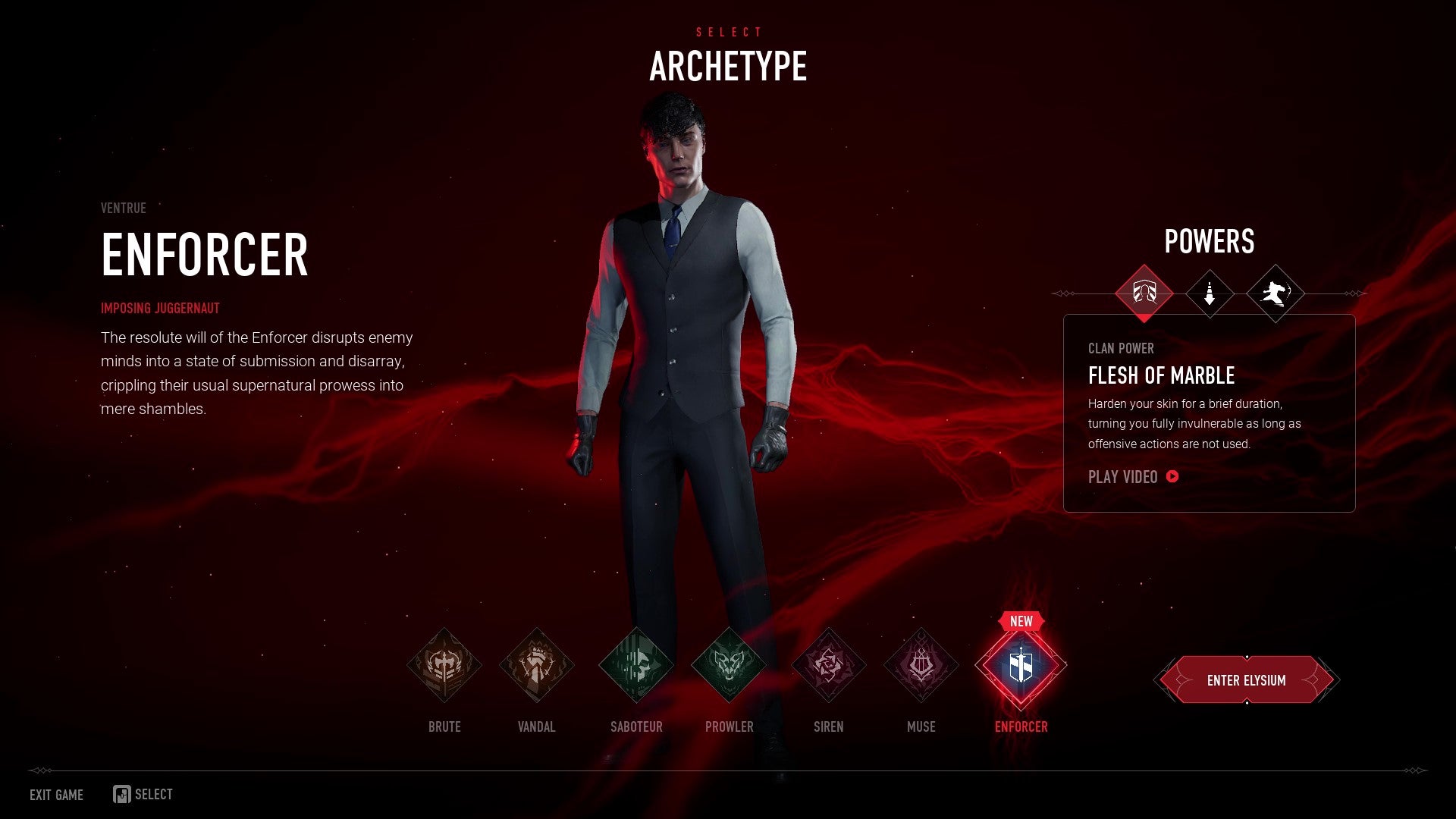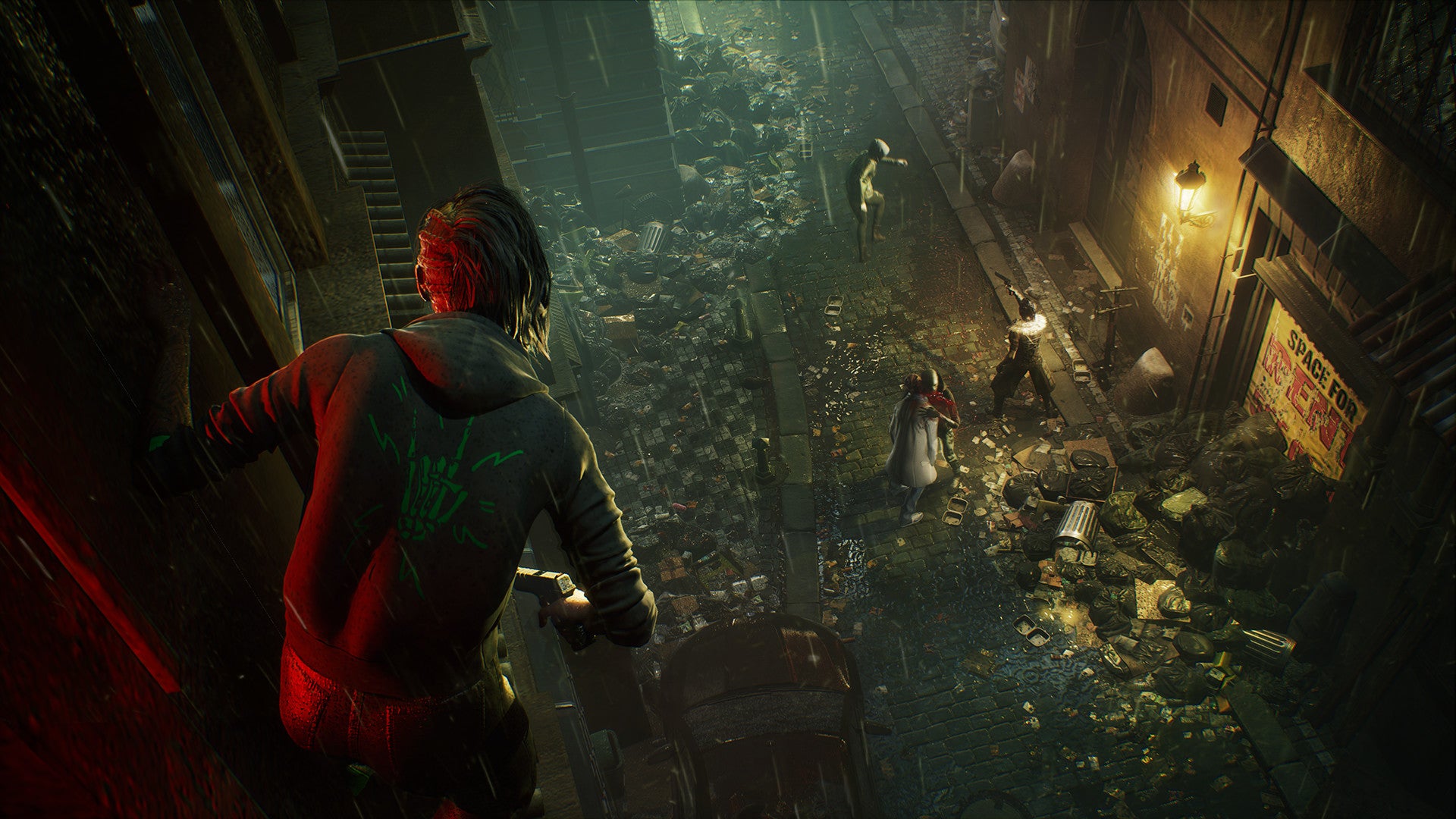Below you’ll find our tier list of the best archetypes in Bloodhunt. Keep reading and you’ll learn the abilities of each clan and archetype, and how to play in a way which complements the strengths of your chosen character.
Best archetype in Bloodhunt tier list
Here’s our tier list for the best archetypes in Bloodhunt, ranked from best to worst: With Bloodhunt’s full release, a meta has quickly emerged favouring archetypes who can switch between ranged and close combat, but with a particular focus on melee and 1v1 skills. This is because, in the late stages of the match, any survivors are hemmed into an absoutely tiny space by the red mist which intermittently closes in to shrink the map. When this happens, long-ranged or support-based archetypes lose a lot of their early-game advantage. Below are our rankings of all the Bloodhunt characters ranging from best to worst. Keep scrolling to read more about each archetype, their abilities, and why they have been placed where they have in our tier list.
Vandal
Clan Power (Brujah): Soaring Leap - Perform a powerful jump forward. Passive Power: Adrenaline Rush - Gain moderate damage resistance when in close vicinity of enemies. Archetype Power: Earth Shock - Leap forward and crash upon the ground, dealing damage and hurling enemies upward. Pros: Excellent beginner class, able to deal and absorb damage at elevated levels with a blend of offence and defence in melee. Cons: Focus on melee skills means that you’ve got limited power at range and almost no stealth skills compared to other clans.
Armed both with its Clan’s Soaring Leap skill and its unique Earth Shock ability, the Vandal is peerless when it comes to crossing vast distances in the blink of an eye. Both these abilities are far stronger than the other movement skills in the game when it comes to scaling rooftops because of the forward momentum that both jumps provide. Another key strength of the Vandal is the Adrenaline Rush passive, which provides damage resistance when in close proximity of enemies, which in turn means you always know when enemies are nearby. Considering how hairy things can get in the close-quarters combat at the end of a match, this melee-oriented kit has elevated the Vandal right to the top of our Version 1.0 tier list, narrowly edging out their powerful Brujah sibling the Brute.
Brute
Clan Power (Brujah): Soaring Leap - Perform a powerful jump forward. Passive Power: True Grit - Replenish up to half health while not taking damage. Archetype Power: Shockwave Punch - Unleash a shockwave capable of deflecting bullets. Pros: Excellent beginner class, able to deal and absorb damage at elevated levels with their defence-focused melee skills. Cons: Same as the Vandal’s, plus solo players will struggle to make use of their support-focused abilities once the end-of-match free-for-all starts.
Both Brujah clan archetypes are a cut above the rest thanks to their Soaring Leap movement skill, which is the best ability in the game for fast rooftop traversal. It’s a close call as to which is better and the Brute actually beats out the Vandal in squad matches, where their Shockwave Punch can effectively shield their entire team. Add to this the Brute’s True Grit passive heal, which quickly gets them back up to half-health after only spending a couple of seconds out of combat, and you’ve got an archetype that excels at getting in and out of sticky situations - of which there are a great many waiting for you in the crowded streets and rooftops of vampire-infested Prague.
Siren
Clan Power (Toreador): Projection/Dash - Send out a projection of yourself, which you can teleport to at will. Passive Power: Kindred Charm - Nearby civilians are charmed, temporarily making them act friendly towards you and your team. Archetype Power: Blinding Beauty - Slowly erupt into pure beauty, blinding and damaging all nearby enemies. Pros: Has the easiest time collecting specific Resonances and farming extra lives, and excels in close combat. Cons: Close-combat skills can be easily circumvented by ranged characters or those with escape skills.
The greatest unique benefit to playing as the Siren is the safety provided by Kindred Charm, which entrances nearby Mortals: making it easier to go after specific Blood Resonance types, invaluable in Version 1.0 for picking up extra lives while also making it less likely that you’ll ever become the target of a Bloodhunt. The other skill in the Siren’s repertoire is Blinding Beauty, an inititation skill which blinds and damages enemies within close range. This makes the Siren an effective melee character, as you can use Projection/Dash to close the distance between you and an enemy, blind them, and then hack them down with gusto. Be quick, though: all it takes is for the enemy to have any kind of escape skill to put some distance between you, and you’ll be robbed you of your main advantage in battle.
Enforcer
Clan Power (Ventrue): Flesh of Marble - Harden your skin for a brief duration, turning you fully invulnerable as long as offensive actions are not used. Passive Power: Subjugating Presence - Nearby enemies have their movement speed slowed. The Ventrue is also alerted when the enemy would step into their presence. Archetype Power: Unyielding Charge - Rush forward dealing moderate damage and silencing enemies for a brief duration. Silenced enemies cannot use vampiric powers while affected. Pros: Jack-of-all-trades, can do a bit of everything every other archetype offers. Cons: Master-of-none, lacks the finishing power of an archetype who specialises in one skill area.
All three of the Enforcer’s powers bring something truly unique to the table: it’s the only archetype which can activate complete invulnerability (Flesh of Marble) or disable the vampiric powers of opponents (Unyielding Charge), and the passive ability to slow down the movement speed of nearby enemies with Subjugating Presence is a lovely bonus. Really the only downside is the lack of a powerful follow-up attack after that shoulder barge has silenced an enemy; and despite this single drawback, it’s still an archetype you can have a huge amount of fun playing.
Prowler
Clan Power (Nosferatu): Vanish - Become invisible and move rapidly for a brief duration. Passive Power: Sense The Beast - Severely wounded enemies leave a trail that reveals their recent movement. Archetype Power: Scouting Famulus - Send out bats to scout an area, temporarily revealing enemies through walls. Pros: The only archetype able to track enemies, can use their clan power to move stealthily. Cons: Improvements to the mini-map in Version 1.0 have removed some of their scouting advantages compared to other archetypes.
The Prowler is Bloodhunt’s tracker class, and they’re a very fun archetype to use when things go your way. Vanish is probably the best panic button in the game: just a tap of the button and you’re invisible, and gain a movement speed buff for a short time to help reposition or elude your enemy. But the true power of the Prowler comes from its unique skills: Sense The Beast allows you to see very clear trails left behind by heavily injured enemies, which means it’s the easiest thing in the world to follow them. Of course, it’s only useful when you have the upper hand in a fight - so to help you initiate combat, you’ve also got the Scouting Famulus ability, which sends a swarm of bats to a target location, which will send out pulses in that area over time that can reveal nearby enemies, even through walls. It can take some time to learn how to use these bats effectively, but the result is unparelleled situational awareness.
Saboteur
Clan Power (Nosferatu): Vanish - Become invisible and move rapidly for a brief duration. Passive Power: Unseen Passage - Turn semi-invisible while crouching. Archetype Power: Sewer Bomb - Throw a bomb that explodes and releases toxic gas when approached by enemies. Pros: The best stealth class in the game thanks to their combination of non-combat skills. Cons: What passes for their offensive skills are risky and difficult to control out in the open, where most of Bloodhunt’s combat takes place.
A skilled Saboteur may lack the awareness of the Prowler, but can still be an absolute menace to contend with thanks to its stealthy inclinations. Not only does the Saboteur enjoy the use of Vanish, which gives them strong repositioning and escape capabilities; but with the Unseen Passage skill they can also turn semi-invisible (still perceptible, but hard to spot) after a moment whenever they crouch. This is particularly powerful in the late-game when everyone is on rooftops close together looking for snipes and easy kills. The other trick up the Saboteur’s sleeve is the Sewer Bomb - a proximity device that can be lobbed a fair distance and connects onto the first surface it finds. When an enemy gets within its range, the bomb detonates into a cloud of gas, damaging and muddying the vision of enemies that stay in the cloud, and - most importantly - acting as a warning of that enemy’s location.
Muse
Clan Power (Toreador): Projection/Dash - Send out a projection of yourself, which you can teleport to at will. Passive Power: Final Act - Instantly refresh your cooldowns and enable the use of powers when downed. Archetype Power: Rejuvenating Voice - Heals yourself and nearby allies while channelled. Taking damage interrupts the heal. Pros: Bloodhunt’s premier healer class, very desirable for squad mode. Cons: Poor combat abilities render the Muse reliant on teammates for protection, or forced to simply run away in solo play.
The placement at the bottom of this list shouldn’t be taken to mean that the Muse isn’t powerful: they’re just the hardest archetype to win games with unless you really know what you’re doing. Get the hang of them and the Muse can be a very rewarding class to play as, thanks to the high skill ceiling Projection/Dash ability, which you can use to wrongfoot enemies and effectively escape bad situations with a bit of forward planning; and the sometimes-game-changing Final Act passive, which gives you the use of your abilities even while downed. The Muse is also Bloodhunt’s healer class, thanks entirely to its Rejuvenating Voice skill, a channelling spell which heals yourself and allies within range over time. You’re obviously very vulnerable while healing though, and any damage you take interrupts the heal.
Best archetype for beginners
I’m always recommending new VTM players to consider playing as a Brujah, whether they’re dipping a toe into the TTRPG or checking out Bloodlines for the first time. This advice holds true in Bloodhunt, where the Brujah’s high resistance to damage and tough melee attacks make them a solid choice for newbies. Either Brujah archetype makes for a good introductory character, though thanks to the Brute’s skills lending themselves to a more supporting role, I recommend the Vandal as a more classic Brujah solo experience to those just starting out. Despite the Ventrue clan being an extremely unlikely choice in an action-oriented game like Bloodhunt, the Enforcer is actually surprisingly good for beginners, too. The Enforcer manages to be a solid combat character without losing the essence of what their clan’s about. Playing them essentially gives you a taste of what every other class currently in the game has to offer: mixing less powerful versions of the Brujahs’ melee and resistance with the Toreadors’ enemy power-draining and the Nosferatus’ propensity for stealth.
Best archetype for solo players
Given my unapologetic love for the Brujah you’ll be unsurprised to learn that I think the Vandal is the top choice for solo play thanks to their excellent mobility, aggressive melee style, and the fact that they actually get a bit stronger in the presence of enemies. You don’t need to be afraid to jump into the thick of it when you’re playing as a solo Vandal. For those looking to change things up, though, the Enforcer can by design do a bit of everything, making them a good shout when forming a one-person army. Used correctly, the Siren can hold their own too, with the one-two punch of their clan and archetype powers bringing a world of pain on enemies within their reach (although Nosferatus in particular can potentially no-sell this combat style, making it the riskiest of my three recommendations for solo play).
Best archetype for support players
So far, each of Bloodhunt’s three original clans has an archetype that lends itself particularly well to taking on a support role in squad matches. For those who like to play the healer, the Muse has the best healing powers in the game and can heal their teammates as well as themself even when downed. Unfortunately, that’s likely to happen a lot, so the other members of the squad just need to be prepared to keep an eye on their Muse. If you like to do a bit of shielding, the Brute is the top choice, with their Shockwave Punch capable of deflecting bullets in an AoE to also protect their squadmates. Finally, if gathering intel is your bag, then it’s ridiculously satisfying to track enemies with the Prowler’s superior kit and feed all those unsuspecting bloodsuckers’ locations back to your squad. As you can probably tell, each of the Bloodhunt archetypes brings at least one (and often two or three) very powerful skills to the table, and any of them can be used to win a match. Hopefully this primer has given you a better idea of the abilities each archetype has at their disposal. If you’re struggling to earn kills and wins, then try a different character - or perhaps develop your own skills with our top Bloodhunt tips and tricks guide for beginners!







